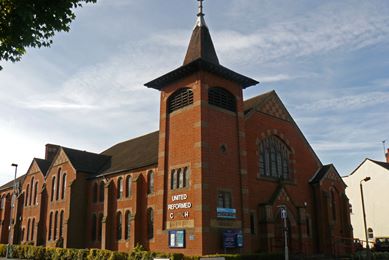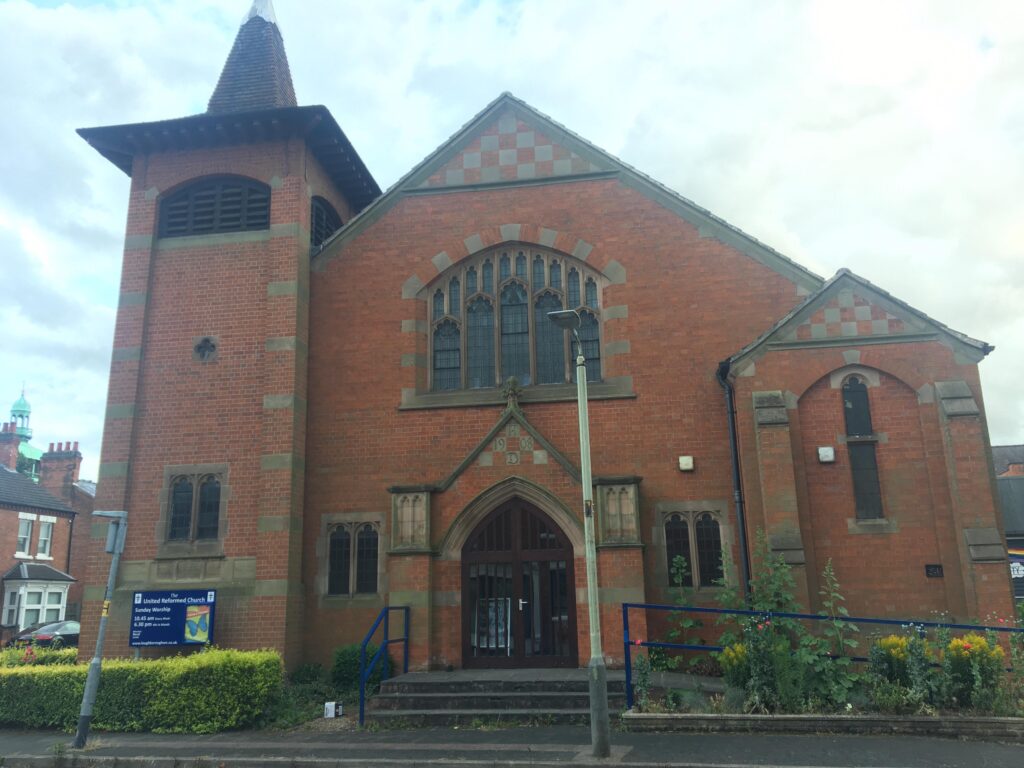Loughborough United Reformed Church
28 June 2020
The United Reformed Church – formerly Loughborough Congregational Church – opened on Frederick Street in July 1908.
At this point, Congregationalism had existed in the town for 80 years, its early days being ‘full of hardship and trial.’*
After meeting in rooms in Mill Street and Sparrow Hill, the congregation had opened a chapel in Ashby Square on the site of the former cockpit. Built in 1828 when the congregation were more commonly known as the Independents, the old chapel was subsequently used as the Masonic Hall.
The Gothic style Frederick Street church and adjoining hall were designed at a cost of about £5000 by Loughborough architects Barrowcliff & Allcock, who also designed the nearby Loughborough Town Baths and Carnegie Library, as well as Rosebery Street School.
The move to Frederick Street was ‘no little thing to embark on’, leaving the congregation owing in the region of £2,500 (the equivalent of approx. £3000,000 today) for its construction. The pastor at the time of the move was the Rev W J Wray.
The new church was officially opened on Wednesday 15th July 1908. Sir Joseph Compton-Rickett preached at the day-time opening service. He was ex-chairman of the Congregational Union and a former businessman who had entered politics as a Liberal MP. He later became Paymaster General in Lloyd George’s wartime government.
After the service, a large number of people sat down to tea in the school rooms and this was followed in the evening by a meeting at which Professor David L Ritchie spoke. Professor Richie was Principal of the Nottingham Congregational Institute, a theological training college for Congregational ministers. The college was founded in 1866 by the Rev J M Paton and now bears his name.
The following Christmas, the Echo reported that the choir of the Congregational Church gave a performance of ‘The Messiah’, conducted by Dr Paltridge.
In the 1950s, the College School used the school rooms behind the church and the huts to the side for lessons until moving to their purpose-built school on Thorpe Hill.
Cubs and Scouts also met in the premises in that period before moving to their own building in Thorpe Acre Village. Brownies met at the buildings in the 80s, too, and the rooms have regularly been used by other local community groups, including the WI and a local dance school. In the late 1980s/early 1990s they became the temporary home for Loughborough’s Salvation Army when their own building was demolished in the Rushes and the new building to replace it was being built. (This building has since become a solicitors.)
In the early 1970s, the Congregational Churches and Presbyterian Churches in England and Wales joined together to form the United Reformed Church.+
Compiled by Alison Mott
*’The Story of Loughborough 1888-1914,’ by W A Deakin (Published by Echo Press Ltd in 1979)
+The website of Loughborough United Reformed Church
With many thanks to members of the Remember Loughborough Facebook Group for additional historical information and anecdotes, including Graham Hulme and Colin Price, Mick Hubbard, Una Hubbard, David Wilson, Janet Grant, Jo Bailey Cole and John Cope.
Read about Sunday services at the church in past days here.

Photograph courtesy of Colin Price.

Can you add extra detail to this article? Do you have photographs or memories of the church on Frederick Street you could share? Email us at lboro.history.heritage@gmail.com.